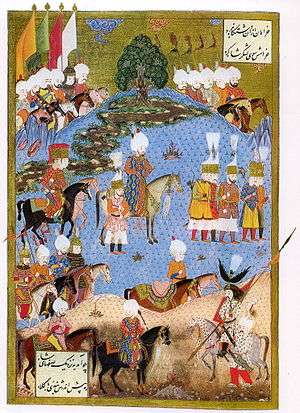Süleymanname

Suleiman marching with his army in Nakhichevan, summer 1554, during the Ottoman-Safavid War of 1532-1555. One of the scenes of the Süleymannâme.
The Süleymannâme (lit. "Book of Suleiman") is an illustration of Suleiman the Magnificent's life and achievements. In 65 scenes the miniature paintings are decorated with gold, depicting battles, receptions, hunts and sieges. Written by Fethullah Arifi Çelebi in Persian verse,[1] and illustrated by five unnamed artists, the Süleymannâme was the fifth volume of the first illustrated history of the Ottoman dynasty.[1] It was written in the manner of the Iranian Shahnameh epic.[2] The original version of the Süleymannâme lies in the Topkapi Palace Museum in Istanbul.
References
- 1 2 Smith 2015, p. 164.
- ↑ Grabar 1989, p. 1.
Sources
- Atil, Esin (1986). Suleymanname: The Illustrated History of Suleyman the Magnificent. H.N. Abrams. p. 271. ISBN 978-0894680885.
- Grabar, Oleg (1989). Muqarnas: An Annual on Islamic Art and Architecture. Brill Archive. ISBN 978-9004090507.
- Smith, Charlotte Colding (2015). Images of Islam, 1453–1600: Turks in Germany and Central Europe. Routledge. ISBN 978-1317319634.
| Wikimedia Commons has media related to Süleymanname. |
This article is issued from
Wikipedia.
The text is licensed under Creative Commons - Attribution - Sharealike.
Additional terms may apply for the media files.